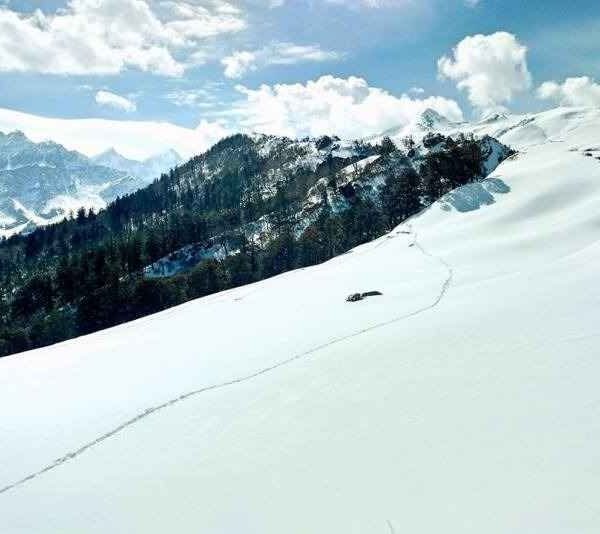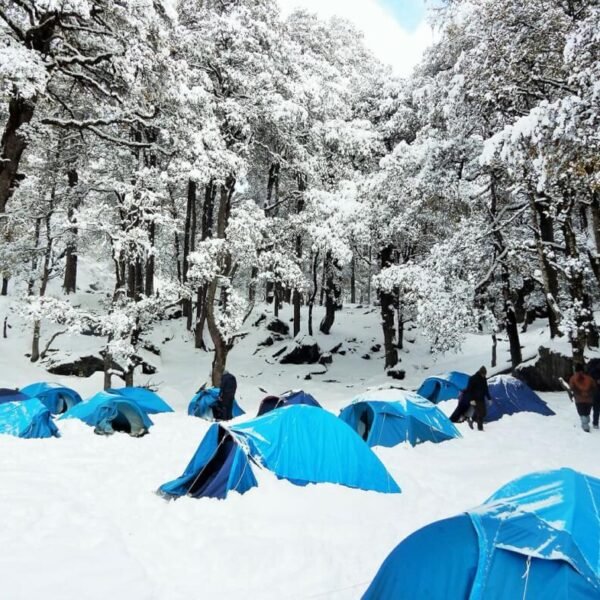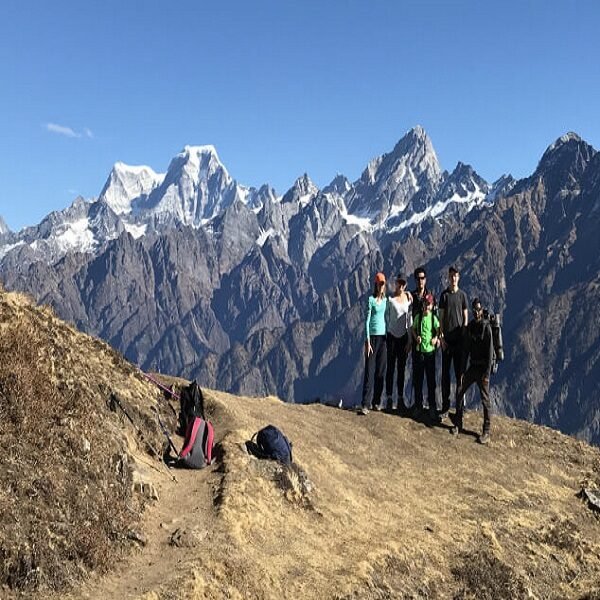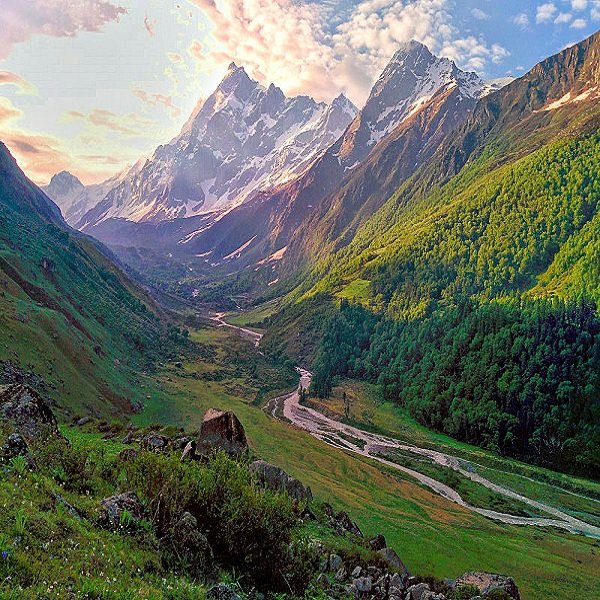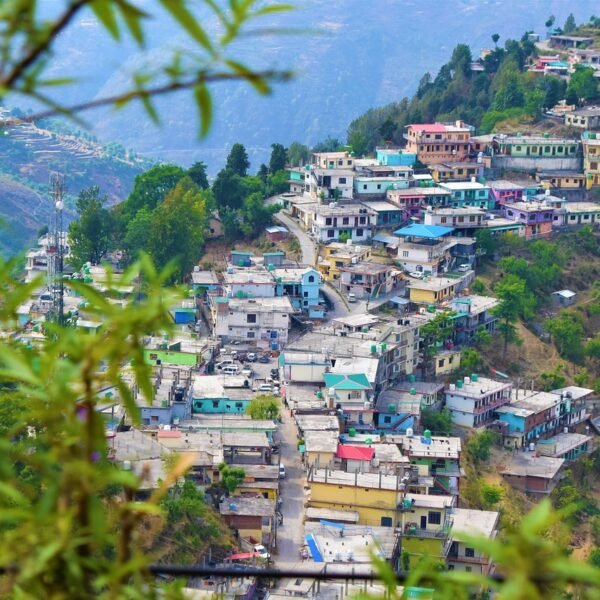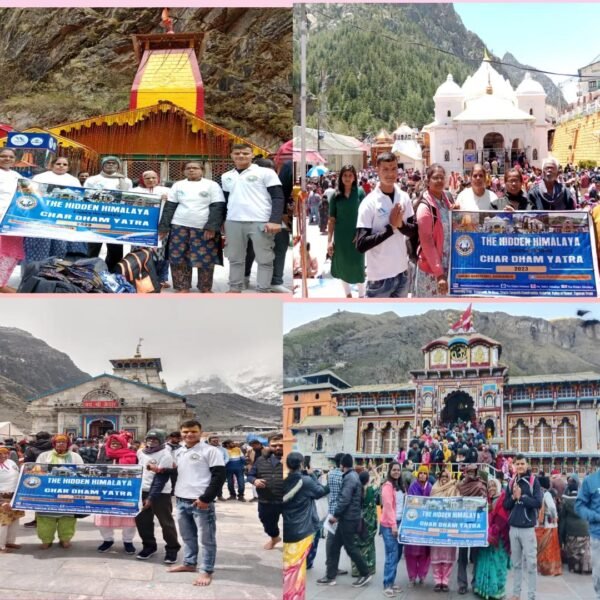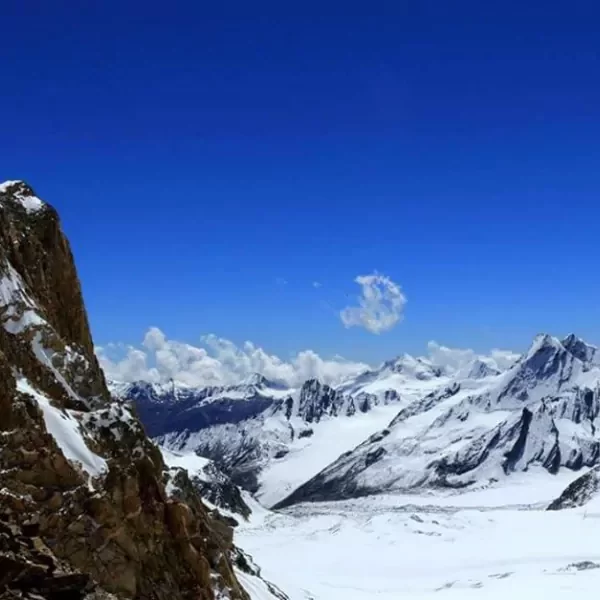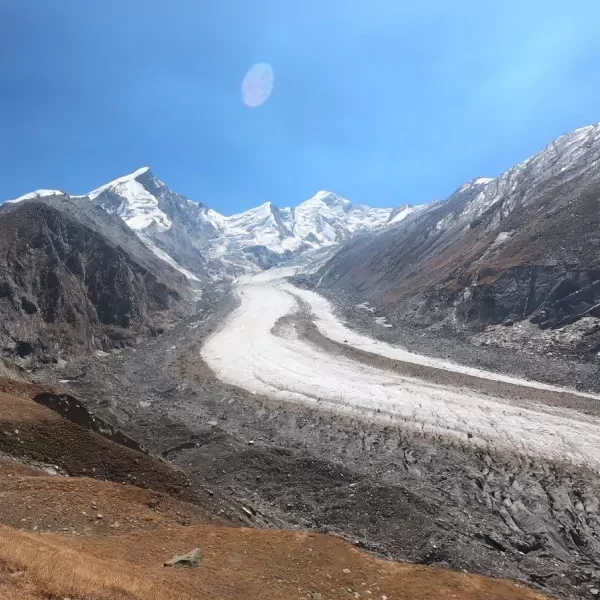Kuari Pass Trek
Overview
Kuari Pass Trek
The Kuari Pass Trek, also known as the Curzon Trail, is a popular trekking route in the Garhwal Himalayas of Uttarakhand, India. This scenic trek offers breathtaking views of snow-capped peaks, lush meadows, dense forests, and pristine alpine lakes, making it a favorite among trekkers and nature enthusiasts.
The trek typically starts from the village of Joshimath and ascends through charming villages, rhododendron forests, and alpine meadows. Along the way, trekkers are treated to panoramic vistas of iconic peaks like Nanda Devi, Kamet, Dronagiri, and Trishul.
One of the highlights of the Kuari Pass Trek is reaching Kuari Pass itself, situated at an altitude of approximately 3,650 meters above sea level. From the pass, trekkers can enjoy mesmerizing views of the surrounding Himalayan peaks and valleys, creating unforgettable memories.
Kuari Pass Trek is suitable for trekkers of all experience levels, from beginners to seasoned adventurers. The well-defined trail, moderate altitude, and gradual ascents make it accessible to a wide range of enthusiasts.
History of Kauri Pass
The history of Kuari Pass, also known as Kauri Pass, is deeply rooted in the ancient trade routes of the Himalayas. Historically, Kuari Pass served as a crucial trade route between the regions of Tibet and India, facilitating the exchange of goods, culture, and ideas between the two civilizations.
Additionally, Kuari Pass holds significance in the realm of mountaineering and exploration. It gained prominence in the early 20th century when British mountaineer Lord Curzon, then Viceroy of India, undertook an expedition to explore the region. This expedition played a pivotal role in popularizing Kuari Pass as a trekking destination among adventurers and outdoor enthusiasts.
Furthermore, Kuari Pass has been a part of various historical and cultural narratives, including ancient Hindu mythology and folklore. It is believed to be associated with the epic Mahabharata, with mentions of the pass in various Hindu scriptures and legends.
Today, Kuari Pass continues to attract trekkers from around the world, drawn by its stunning vistas, rich cultural heritage, and historical significance. It stands as a testament to the enduring legacy of exploration and adventure in the majestic Himalayan region.
Mountain Ranges Visible From Kuari Pass
From Kuari Pass, trekkers are treated to breathtaking views of several majestic mountain ranges in the Garhwal Himalayas of Uttarakhand, India. Some of the prominent mountain ranges visible from Kuari Pass include:
- Nanda Devi Range: The Nanda Devi Range is one of the most iconic and majestic mountain ranges in the Indian Himalayas. It includes the towering peak of Nanda Devi, the second highest mountain in India.
- Dronagiri Range: The Dronagiri Range is characterized by its rugged peaks and dramatic ridgelines. It includes peaks such as Dronagiri Parbat and Changabang, offering spectacular views from Kuari Pass.
- Kamet Range: The Kamet Range is known for its high peaks, including Kamet, the third highest mountain in India. Trekkers can admire the snow-capped summits of this range from Kuari Pass.
- Trishul Range: The Trishul Range is named after its three prominent peaks resembling a trident. It includes peaks like Trishul I, Trishul II, and Trishul III, adding to the stunning panorama visible from Kuari Pass.
- Chaukhamba Range: The Chaukhamba Range is characterized by its four prominent peaks, with Chaukhamba I being the highest. Trekkers can enjoy panoramic views of this range from Kuari Pass, adding to the awe-inspiring beauty of the surroundings.
These mountain ranges offer a majestic backdrop to the breathtaking vistas visible from Kuari Pass, making it a truly unforgettable experience for trekkers and nature enthusiasts alike.
Kauri Pass Bird Watching Flora, fauna and Animals
The Kuari Pass trek presents a haven for birdwatchers and nature enthusiasts, offering a diverse range of avian species and wildlife amidst its breathtaking landscapes. As trekkers navigate through the picturesque trails, they are greeted by a symphony of birdcalls and sightings of various bird species.
Birdwatchers can expect to spot a plethora of avian wonders, including the vibrant Himalayan Monal, majestic Golden Eagle, elusive Koklass Pheasant, and the soaring Lammergeier. The alpine meadows and dense forests of the region also provide habitat to numerous songbirds, thrushes, and warblers, adding to the rich tapestry of birdlife.
In addition to birdwatching, trekkers may encounter a variety of wildlife along the Kuari Pass trek. This includes sightings of Himalayan Musk Deer, Bharal (blue sheep), Himalayan Tahr, and occasionally, elusive predators like the snow leopard and black bear. The diverse flora of the region, including rhododendrons, junipers, and alpine flowers, further enriches the trekking experience.
Exploring the birdlife, flora, and fauna of the Kuari Pass trek offers trekkers a deeper connection with nature and a greater appreciation for the biodiversity of the Himalayan region.
Why You Should Go for Kauri Pass Trek
Kuari Pass Trek offers a transformative journey through the stunning landscapes of the Garhwal Himalayas, making it an ideal choice for adventurers seeking a soul-stirring trekking experience. Here's why you should go for this iconic trek:
- Scenic Beauty: The trek treats you to breathtaking views of snow-capped peaks, lush valleys, and pristine alpine meadows, providing a visual feast for nature lovers and photographers alike.
- Majestic Mountain Ranges: From Kuari Pass, you can witness iconic peaks like Nanda Devi, Kamet, Dronagiri, and Trishul, offering a surreal backdrop to your trekking adventure.
- Rich Biodiversity: Explore the diverse flora and fauna of the region, with opportunities to spot rare Himalayan flowers, birds, and occasionally, elusive wildlife like the snow leopard.
- Cultural Immersion: Interact with local villagers, visit ancient temples and monasteries, and immerse yourself in the rich cultural heritage of the Garhwal Himalayas, adding a cultural dimension to your trekking experience.
- Moderate Challenge: Kuari Pass Trek offers a moderate level of challenge, suitable for both novice and experienced trekkers. It involves trekking through varied terrain, providing a thrilling adventure experience.
- Personal Growth: Completing the Kuari Pass Trek fosters personal growth, resilience, and a sense of accomplishment as you conquer rugged terrain and overcome challenges along the way, leaving you with lasting memories and a sense of fulfillment.
- Spiritual Connection: Follow in the footsteps of ancient pilgrims and connect with the spiritual essence of the Himalayas as you traverse sacred landscapes and visit ancient temples and monasteries along the route.
Overall, the Kuari Pass Trek promises an enriching and transformative experience amidst the awe-inspiring beauty of the Garhwal Himalayas, making it a must-do for adventure seekers and nature enthusiasts alike.
Why to choose Kuari Pass Trek?
Choosing the Kuari Pass Trek offers a transformative journey through the stunning landscapes of the Garhwal Himalayas, making it an ideal choice for adventurers seeking a soul-stirring trekking experience. Here's why you should choose the Kuari Pass Trek:
- Scenic Beauty: The trek treats you to breathtaking views of snow-capped peaks, lush valleys, and pristine alpine meadows, providing a visual feast for nature lovers and photographers alike.
- Majestic Mountain Ranges: From Kuari Pass, you can witness iconic peaks like Nanda Devi, Kamet, Dronagiri, and Trishul, offering a surreal backdrop to your trekking adventure.
- Rich Biodiversity: Explore the diverse flora and fauna of the region, with opportunities to spot rare Himalayan flowers, birds, and occasionally, elusive wildlife like the snow leopard.
- Cultural Immersion: Interact with local villagers, visit ancient temples and monasteries, and immerse yourself in the rich cultural heritage of the Garhwal Himalayas, adding a cultural dimension to your trekking experience.
- Moderate Challenge: Kuari Pass Trek offers a moderate level of challenge, suitable for both novice and experienced trekkers. It involves trekking through varied terrain, providing a thrilling adventure experience.
- Personal Growth: Completing the Kuari Pass Trek fosters personal growth, resilience, and a sense of accomplishment as you conquer rugged terrain and overcome challenges along the way, leaving you with lasting memories and a sense of fulfillment.
- Spiritual Connection: Follow in the footsteps of ancient pilgrims and connect with the spiritual essence of the Himalayas as you traverse sacred landscapes and visit ancient temples and monasteries along the route.
Overall, the Kuari Pass Trek promises an enriching and transformative experience amidst the awe-inspiring beauty of the Garhwal Himalayas, making it a must-do for adventure seekers and nature enthusiasts alike.
Is it safe trek for me ?
The safety of any trek depends on various factors, including your physical fitness, experience level, preparation, weather conditions, and adherence to safety guidelines. The Kuari Pass Trek is generally considered safe for trekkers who are adequately prepared and have a reasonable level of fitness.
Here are some factors to consider when assessing the safety of the Kuari Pass Trek:
- Physical Fitness: The trek involves moderate to strenuous levels of physical activity, including ascending and descending uneven terrain. Ensuring that you are physically fit and have undertaken some preparatory training can enhance your safety on the trek.
- Experience Level: Kuari Pass Trek is suitable for both novice and experienced trekkers. However, having some prior trekking experience and familiarity with high-altitude trekking can contribute to a safer and more enjoyable experience.
- Weather Conditions: Weather conditions in the Himalayas can be unpredictable, with sudden changes in temperature, rainfall, and snowfall. It's essential to check weather forecasts before embarking on the trek and be prepared for varying weather conditions.
- Trekking Gear and Equipment: Having the appropriate trekking gear, clothing, and equipment is crucial for safety and comfort during the trek. Ensure that you have sturdy hiking boots, warm clothing, rain gear, a first aid kit, and other essential items.
- Acclimatization: Acclimatizing to the altitude is essential when trekking in high-altitude regions like the Himalayas. It's recommended to take it slow, stay hydrated, and listen to your body to prevent altitude-related illnesses.
- Guide and Support: Hiring a local guide or joining a reputable trekking company can enhance safety by providing local expertise, support, and assistance throughout the trek.
- Safety Guidelines: Following safety guidelines, staying on designated trails, avoiding risky maneuvers, and adhering to the instructions of your guide can significantly contribute to your safety during the trek.
Ultimately, assessing your own capabilities, being adequately prepared, and taking necessary precautions can help ensure a safe and enjoyable trekking experience on the Kuari Pass Trek.
How to difficulty level kuari pass
Kuari Pass Trek is generally considered to be of moderate difficulty level. The trek involves moderate to strenuous levels of physical activity, including ascending and descending uneven terrain. While the trail is well-defined and does not require technical climbing skills, trekkers should be prepared for long trekking days and changes in altitude. The trek's altitude gain and high-altitude passes may pose challenges for some individuals, requiring proper acclimatization and physical fitness. However, with proper preparation, including physical conditioning, acclimatization, and adherence to safety guidelines, trekkers of average fitness levels can successfully complete the Kuari Pass Trek.
What should you keep in mind for the Kuari pass trek?
Kuari Pass Trek, several essential considerations ensure a safe and enjoyable journey. First, prioritize physical fitness by engaging in regular exercise to build endurance for the trek's moderate difficulty level. Acclimatization to the high altitude is crucial; ascend gradually, stay hydrated, and recognize symptoms of altitude sickness. Prepare for varying weather conditions in the Himalayas by packing appropriate clothing layers, including warm layers, rain gear, and sun protection. Invest in quality trekking gear, such as sturdy hiking boots and trekking poles, to navigate the rugged terrain comfortably. Maintain environmental consciousness by practicing Leave No Trace principles and minimizing your impact on the fragile ecosystem. Stay hydrated, fuel your body with high-energy snacks, and follow safety guidelines to ensure a safe trekking experience. Lastly, familiarize yourself with emergency procedures and carry a basic first aid kit for any unforeseen situations.
Winter Season
winter season, typically spanning from November to February, transforms the Kuari Pass region into a winter wonderland. During this time, the landscape is blanketed in pristine snow, creating a serene and picturesque setting for trekking. The temperatures in the winter season can drop significantly, with daytime temperatures ranging from -5°C to 5°C (23°F to 41°F) and nighttime temperatures plummeting further. Heavy snowfall is common during this season, covering the trails and surrounding mountains in a thick layer of snow. Trekking during winter requires specialized gear for cold weather, including insulated clothing, sturdy boots, and crampons for traction on icy trails. Despite the challenges, winter trekking offers a unique and serene experience, with fewer crowds and breathtaking views of snow-capped mountains.
Summer Season
- The summer season, from March to June, brings milder temperatures and clear skies to the Kuari Pass region.
- The landscape comes alive with vibrant colors as wildflowers bloom across the alpine meadows, creating a picturesque setting for trekking.
- Trekking during summer offers comfortable weather conditions, making it an ideal time for beginners and families to explore the region.
- The trails are relatively dry and free from snow, allowing for easier navigation and accessibility to higher altitudes.
- Summer trekking provides ample opportunities for birdwatching, wildlife spotting, and enjoying the stunning natural beauty of the Himalayas.
Monsoon Season
- The monsoon season, from July to September, brings heavy rainfall and occasional thunderstorms to the Kuari Pass region.
- Trekking during this season can be challenging due to slippery trails, landslides, and reduced visibility caused by fog and mist.
- The lush greenery and blooming flora create a vibrant atmosphere, but trekkers must exercise caution and be prepared for adverse weather conditions.
- It's advisable to check weather forecasts regularly and plan trekking routes accordingly to avoid areas prone to landslides and flash floods.
- Despite the challenges, trekking during the monsoon season offers a unique perspective of the region's natural beauty, with cascading waterfalls and verdant landscapes.
Altitude we are going to cover in This Trek
Kuari Pass Trek covers a significant altitude range, starting from the base elevation of approximately 1,800 meters (5,905 feet) and ascending to the highest point around 3,650 meters (11,975 feet) above sea level. This ascent involves a gain in altitude of approximately 1,850 meters (6,070 feet). The trek offers trekkers the opportunity to experience the gradual transition from lower elevations characterized by lush forests and meadows to higher altitudes where alpine vegetation and snow-capped peaks dominate the landscape. Adequate acclimatization and physical fitness are essential to navigate the altitude variations comfortably and safely during the Kuari Pass Trek.
Key Points of Kuari pass trek
Duration: The duration of the Kuari Pass Trek typically ranges from 6 to 7 days, including travel to and from the base camp.
Base Camp: The trek usually starts from the village of Joshimath in Uttarakhand, India, serving as the base camp for the Kuari Pass Trek.
Summer Temperature: During the summer season (March to June), the temperature in the Kuari Pass region ranges from 10°C to 20°C (50°F to 68°F) during the day and may drop to 5°C to 10°C (41°F to 50°F) at night.
Winter Temperature: In winter (November to February), the temperature can plummet to sub-zero levels, with daytime temperatures ranging from -5°C to 5°C (23°F to 41°F) and nighttime temperatures dropping further.
Altitude: The highest point of the trek is Kuari Pass, situated at an altitude of approximately 3,650 meters (11,975 feet) above sea level.
Best Time: The best time to undertake the Kuari Pass Trek is during the months of April to June and September to November when the weather is pleasant, and the trails are relatively dry and snow-free.
Trek Level: The Kuari Pass Trek is considered to be of moderate difficulty level, suitable for trekkers with basic fitness levels. It involves moderate to strenuous ascents and descents, requiring moderate physical endurance.
Trek Distance: The total trekking distance for the Kuari Pass Trek is approximately 30 to 35 kilometers (18 to 22 miles), covering a round-trip route from the base camp to Kuari Pass and back.
Short Itinerary of Kuari pass Trek –
Day 1: Haridwar to Joshimath
- Depart from Haridwar and drive to Joshimath.
- The journey takes approximately 10-12 hours, covering a distance of around 260 kilometers.
- Arrive in Joshimath, check into a guesthouse or hotel, and spend the night.
Day 2: Joshimath to Gulling Camp
- After breakfast, drive to the starting point of the trek at Dhak village (approximately 12 kilometers from Joshimath).
- Begin trekking from Dhak village to Gulling Camp, situated at an altitude of around 2,450 meters.
- The trek takes approximately 4-5 hours, covering a distance of approximately 9 kilometers.
- Set up camp at Gulling, enjoy dinner, and spend the night camping under the stars.
Day 3: Gulling Camp to Tugasi Village
- Wake up early, have breakfast, and start trekking towards Tugasi Village.
- The trail passes through dense forests and picturesque meadows, offering stunning views of the surrounding mountains.
- Arrive at Tugasi Village, located at an altitude of around 2,900 meters, after approximately 5-6 hours of trekking.
- Settle into the village homestay accommodation, interact with locals, and experience the traditional way of life.
- Enjoy dinner and spend the night in Tugasi Village.
Day 4: Tugasi Village to Khullara Camp
- After breakfast, resume trekking towards Khullara Camp.
- The trail ascends gradually, passing through scenic landscapes with panoramic views of snow-capped peaks.
- Arrive at Khullara Camp, situated at an altitude of around 3,350 meters, after approximately 6-7 hours of trekking.
- Set up camp at Khullara, enjoy dinner, and spend the night camping amidst the Himalayan wilderness.
Day 5: Khullara Camp to Kuari Pass to Tali Camp
- Wake up before dawn and start trekking towards Kuari Pass to witness the sunrise over the Himalayan peaks.
- Reach Kuari Pass, situated at an altitude of around 3,650 meters, and soak in breathtaking views of Nanda Devi, Dronagiri, Kamet, and other majestic peaks.
- Descend from Kuari Pass and continue trekking towards Tali Camp, located at an altitude of around 3,250 meters.
- Arrive at Tali Camp after approximately 7-8 hours of trekking, set up camp, enjoy dinner, and spend the night camping at Tali.
Day 6: Tali Camp to Auli to Haridwar
- After breakfast, trek downhill from Tali Camp to Auli, a famous ski resort.
- From Auli, drive back to Haridwar, marking the end of the Kuari Pass Trek.
- The journey from Auli to Haridwar takes approximately 10-12 hours by road.
- Arrive in Haridwar, bid farewell to fellow trekkers and guides, and depart for onward journeys.
How to reach Kuari Pass Trek ?
Option 01:- By Train
- The nearest railway station to the Kuari Pass Trek is Haridwar Railway Station.
- Haridwar is well-connected to major cities like Delhi, Mumbai, Kolkata, and Chennai via regular train services.
- From Haridwar Railway Station, you can hire a taxi or take a bus to Joshimath, the base camp for the Kuari Pass Trek.
Option 02:- By Air –
- The nearest airport to the Kuari Pass Trek is Jolly Grant Airport in Dehradun.
- Dehradun is connected to major cities like Delhi, Mumbai, Bangalore, and Kolkata by regular flights.
- From Dehradun Airport, you can hire a taxi or take a bus to Joshimath, the base camp for the Kuari Pass Trek.
Option 03:- By Bus
- There are regular bus services from Delhi, Dehradun, and Rishikesh to Joshimath, the base camp for the Kuari Pass Trek.
- The bus journey from Delhi to Joshimath takes approximately 12-14 hours, while from Dehradun or Rishikesh, it takes around 9-10 hours.
- Once you reach Joshimath, you can hire a taxi or take a shared jeep to Dhak village, the starting point of the Kuari Pass Trek.
These are the three main options to reach the Kuari Pass Trek, offering flexibility for travelers coming from different parts of India.
Included/Exclude
- Porters
- Forest Permit and entrance fee
- Accommodation in Hotel on twin share basis
- All meals: breakfast, packed lunch, tea, coffee, snacks, soup and Dinner
- Good Experience Local Trek Leader guide and Technical guide
- Medical Kit
- Oxygen Cylinder
- Personal Insurance
- Medical Certificate
- Personal toiletry Items
- Personal Medicine kit
Tour Amenities
Related Tours
- Quality5
- Amenities5
- Services5
- Price5
Chopta Tungnath & Chandrashila Trek
Review Scores
Best Deals

Mountains

Himalaya
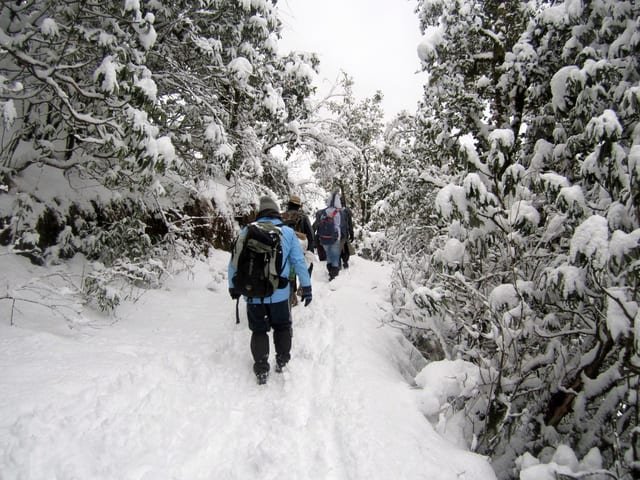
Expeditions




